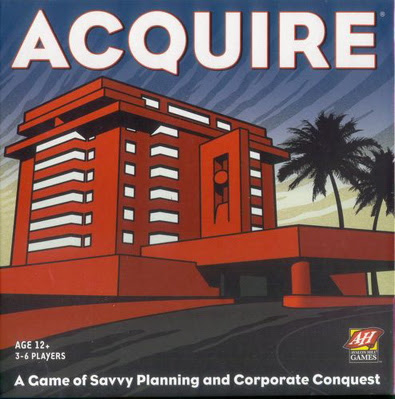 I know next to nothing about hotel management, but it's not hard to imagine hotel chains sprawling across the country, always growing and large chains swallowing up smaller ones. Acquire is a classic game (this latest version is from Avalon Hill Games) for 3-6 players where players manage and plan hotel chains to get the most money from stock, sales, and takeovers.
I know next to nothing about hotel management, but it's not hard to imagine hotel chains sprawling across the country, always growing and large chains swallowing up smaller ones. Acquire is a classic game (this latest version is from Avalon Hill Games) for 3-6 players where players manage and plan hotel chains to get the most money from stock, sales, and takeovers.Acquire plays out on a simple rectangluar board, 12 spaces across and 9 spaces down; tiles are labeled with letters and numbers, such as 2A, 9I, etc. At the start each player gets $6000 and places a tile on the board; whoever's tile is closest to the top left (1A) spot goes first. Each player then gets six tiles.
On a player's turn they place one of their tiles on the board. If the piece stands alone, nothing happens. If they connect with another single piece, they've founded a hotel chain! The player chooses one of the available hotel chains (there are seven at the start: two worth less, two worth more, and three even ones), puts that hotel chain marker on the pieces, and gets a free share of stock in the new hotel chain. If the piece connects with an existing hotel chain, that chain gets bigger. And if a player's piece brings two existing hotel chains together, a merger happens (unless a chain is 11 or more tiles long, in which case it's "safe" and can't be merged).
 Mergers are the key to Acquire, giving players money and stock. When two chains merge, all players count their stock in the smaller, acquired chain. (If the chains are the same size, the player who put down the piece decides which chain is acquired.) Whoever has the most stock in the acquired chain gets the Majority shareholder bonus (based on the hotel chain and its size), while whoever has the next-highest amount of stock in the acquired chain gets the Minority shareholder bonus. After that, players can sell their shares of the minority hotel chain (often the only way to get money), trade in 2 shares of minority chain stock for 1 share of majority chain stock (which can be quite valuable if the majority chain is large), or keep the shares of the minority chain (which are worthless if the chain doesn't return -- but potentially lucrative if the chain comes back). The minority chain is then gone (its marker goes back on the board) and can be founded later.
Mergers are the key to Acquire, giving players money and stock. When two chains merge, all players count their stock in the smaller, acquired chain. (If the chains are the same size, the player who put down the piece decides which chain is acquired.) Whoever has the most stock in the acquired chain gets the Majority shareholder bonus (based on the hotel chain and its size), while whoever has the next-highest amount of stock in the acquired chain gets the Minority shareholder bonus. After that, players can sell their shares of the minority hotel chain (often the only way to get money), trade in 2 shares of minority chain stock for 1 share of majority chain stock (which can be quite valuable if the majority chain is large), or keep the shares of the minority chain (which are worthless if the chain doesn't return -- but potentially lucrative if the chain comes back). The minority chain is then gone (its marker goes back on the board) and can be founded later.After a tile is placed, the player whose turn it is can buy up to 3 stocks of any hotel chain on the board (the larger the chain, the more the stock costs), unless all the stock in a hotel chain has been purchased. If a player declares that a hotel chain is 41 or more tiles long, or that all chains on the board are safe, they can declare the game over. At that point, players get Majority and Minority bonuses for every hotel chain on the board, they sell off all their stock in those hotel chains, and whoever has the most money wins! If the game continues, the player gets a random tile to replace the one they played, and the player on the left then goes.
Acquire is a fun and intriguing game. While the biggest money at the end comes from having majorities in the biggest hotel chains, during the game you'll need to try and have the most shares in the smaller chains to earn bonuses. (It's easy to run out of money buying stock, and if you don't get the Majority or Minority bonus from a merger, you'll have to sell just to be able to buy later.) There's no one strategy for winning, and what may seem like a good plan may backfire (like when I had the most shares in the valuable Continental chain -- which didn't grow or get acquired until the very end of the game). And while knowing what stocks opponents have helps, one big acquisition can turn things around quickly! I was a little disappointed the tile holders were cardboard that warped and didn't hold the tiles well, but Acquire's board is effectively simple (if a little plain), and the reference charts each player gets provides all the pricing for stock andMajority/Minority values a player will need. Acquire won't help you navigate the hotel chain market in the real world -- but it's a blast to play!
Overall grade: B+
Reviewed by James Lynch




























